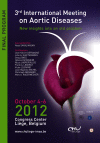New Insights Into Aortic Diseases: A Report From the Third International Meeting on Aortic Diseases (IMAD3)
- PMID: 26798669
- PMCID: PMC4682695
- DOI: 10.12945/j.aorta.2013.13.006
New Insights Into Aortic Diseases: A Report From the Third International Meeting on Aortic Diseases (IMAD3)
Abstract
The current state of research and treatment on aortic diseases was discussed in the "3rd International Meeting on Aortic Diseases" (IMAD3) held on October 4-6, 2012, in Liège, Belgium. The 3-day meeting covered a wide range of topics related to thoracic aortic aneurysms and dissections, abdominal aortic aneurysms, and valvular diseases. It brought together clinicians and basic scientists and provided an excellent opportunity to discuss future collaborative research projects for genetic, genomics, and biomarker studies, as well as clinical trials. Although great progress has been made in the past few years, there are still a large number of unsolved questions about aortic diseases. Obtaining answers to the key questions will require innovative, interdisciplinary approaches that integrate information from epidemiological, genetic, molecular biology, and bioengineering studies on humans and animal models. It is more evident than ever that multicenter collaborations are needed to accomplish these goals.
Keywords: Aortic aneurysm; Epidemiology; Genetics; Surgical repair; Valvular disease.
Figures
References
-
- Kuivaniemi H, Tromp G, Carey DJ, Elmore JR. The molecular biology and genetics of aneurysms. In: Homeister JW, Willis MS, eds. Molecular and Translational Vascular Medicine. New York, NY: Springer Science+Business Media; 2012;3–33.
-
- Kappanayil M, Nampoothiri S, Kannan R, Renard M, Coucke P, Malfait F, et al. Characterization of a distinct lethal arteriopathy syndrome in twenty-two infants associated with an identical, novel mutation in FBLN4 gene, confirms fibulin-4 as a critical determinant of human vascular elastogenesis. Orphanet J Rare Dis. 2012;7:61 10.1186/1750-1172-7-61 - DOI - PMC - PubMed
LinkOut - more resources
Full Text Sources
Other Literature Sources
Miscellaneous


